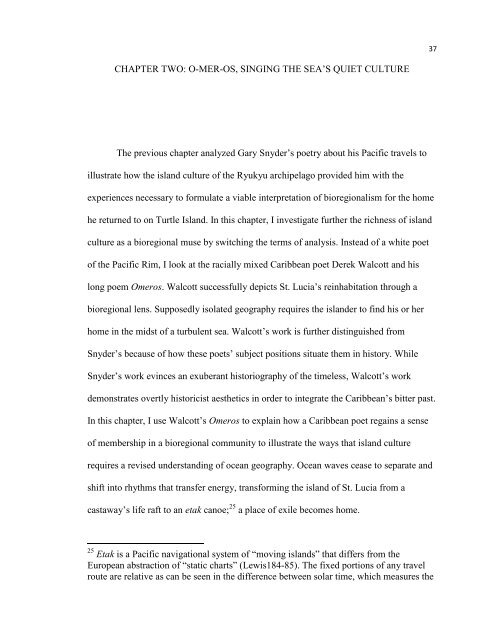RE-INHABITING THE ISLANDS - The University of North Carolina at ...
RE-INHABITING THE ISLANDS - The University of North Carolina at ...
RE-INHABITING THE ISLANDS - The University of North Carolina at ...
Create successful ePaper yourself
Turn your PDF publications into a flip-book with our unique Google optimized e-Paper software.
37<br />
CHAPTER TWO: O-MER-OS, SINGING <strong>THE</strong> SEA‘S QUIET CULTU<strong>RE</strong><br />
<strong>The</strong> previous chapter analyzed Gary Snyder‘s poetry about his Pacific travels to<br />
illustr<strong>at</strong>e how the island culture <strong>of</strong> the Ryukyu archipelago provided him with the<br />
experiences necessary to formul<strong>at</strong>e a viable interpret<strong>at</strong>ion <strong>of</strong> bioregionalism for the home<br />
he returned to on Turtle Island. In this chapter, I investig<strong>at</strong>e further the richness <strong>of</strong> island<br />
culture as a bioregional muse by switching the terms <strong>of</strong> analysis. Instead <strong>of</strong> a white poet<br />
<strong>of</strong> the Pacific Rim, I look <strong>at</strong> the racially mixed Caribbean poet Derek Walcott and his<br />
long poem Omeros. Walcott successfully depicts St. Lucia‘s reinhabit<strong>at</strong>ion through a<br />
bioregional lens. Supposedly isol<strong>at</strong>ed geography requires the islander to find his or her<br />
home in the midst <strong>of</strong> a turbulent sea. Walcott‘s work is further distinguished from<br />
Snyder‘s because <strong>of</strong> how these poets‘ subject positions situ<strong>at</strong>e them in history. While<br />
Snyder‘s work evinces an exuberant historiography <strong>of</strong> the timeless, Walcott‘s work<br />
demonstr<strong>at</strong>es overtly historicist aesthetics in order to integr<strong>at</strong>e the Caribbean‘s bitter past.<br />
In this chapter, I use Walcott‘s Omeros to explain how a Caribbean poet regains a sense<br />
<strong>of</strong> membership in a bioregional community to illustr<strong>at</strong>e the ways th<strong>at</strong> island culture<br />
requires a revised understanding <strong>of</strong> ocean geography. Ocean waves cease to separ<strong>at</strong>e and<br />
shift into rhythms th<strong>at</strong> transfer energy, transforming the island <strong>of</strong> St. Lucia from a<br />
castaway‘s life raft to an etak canoe; 25 a place <strong>of</strong> exile becomes home.<br />
25 Etak is a Pacific navig<strong>at</strong>ional system <strong>of</strong> ―moving islands‖ th<strong>at</strong> differs from the<br />
European abstraction <strong>of</strong> ―st<strong>at</strong>ic charts‖ (Lewis184-85). <strong>The</strong> fixed portions <strong>of</strong> any travel<br />
route are rel<strong>at</strong>ive as can be seen in the difference between solar time, which measures the
















